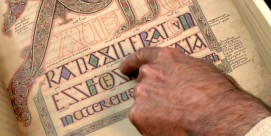God’s Prose and America’s Pen
by David E. Anderson
Pen of Iron: American Prose and the King James Bible by Robert Alter (Princeton University Press, 2010)
Invisible Conversations: Religion in the Literature of America edited by Roger Lundin (Baylor University Press, 2009)
These two very different but not unrelated books look at the changing influence of Christianity and the King James Version of the Bible on American literature.
Robert Alter’s “Pen of Iron” appears as the English-speaking world is about to celebrate the 400th anniversary of the 1611 translation of the Bible that is a landmark of Jacobean prose and, on a popular level, the most loved of the Bible’s many translations and paraphrases. Alter’s book is tightly focused and sweeping in the specificity of its claims. He takes a commonplace of conventional wisdom—the ubiquity the Bible once had in American elite culture—to argue that the King James translation created “the foundational language and symbolic imagery” of the whole of American culture, especially its prose fiction.
Alter is a literary critic and an important scholar of the Hebrew Bible, or what in the King James Version would be called the Old Testament. In “Pen of Iron” he combines both disciplines to show how stylistic techniques associated with the poetry of the Hebrew Bible—especially parallelism (using the same pattern of words and phrases) and parataxis (short sentences side by side)—were appropriated by the translators of the King James Bible and from there went on to shape the color and tone of American fiction.
“I should like to try to see how the language of the King James Version is worked into the texture of the writing, making possible a kind of strong prose that would not have existed otherwise, and I shall seek to understand how this prose serves as the vehicle for certain distinctively American constructions of reality,” he writes.

King James I
It is an intriguing notion, but ultimately Alter raises more questions than he answers. He rests his argument on a close and detailed reading of single works by two major American writers—Melville’s “Moby-Dick” and Faulkner’s “Absalom, Absalom”—as well as a comprehensive examination of Saul Bellow’s “Seize the Day” and more glancing looks at Hemingway’s “The Sun Also Rises,” Cormac McCarthy’s “The Road,” and Marilynne Robinson’s important novel “Gilead.” While they do not fit his category of prose fiction, he also discusses Lincoln’s Gettysburg Address and Second Inaugural Address.
Alter’s argument is at times reductive, while at other points he seems to conflate style and substance, employing a theological theme or deploying a biblical concept he finds prominent in the Hebrew Bible (“family,” “nationhood,” “land,” for example) to demonstrate the pervasiveness of the King James Version’s prose style.
But is there a unique “biblical style”? The Bible, even the Hebrew Bible, is the creation of many writers, many voices. It is a collection of genres, but even within genres, even within single books such as Genesis or the Psalms scholars identify differing writers, employing differing styles and languages, who may address similar concerns differently.
More importantly, Alter disregards the New Testament, its genres and styles, gospels and epistles, except to mistakenly read the Puritan colonists’ covenant theology as a rejection of the New Testament, thereby making them some kind of quasi-Israelites. But both the gospels and the epistles of the New Testament bring their own distinct linguistic techniques and methods to the Bible’s polyphony of voices. It is myopic to suggest that American prose writers, if they were as steeped in the King James Bible as Alter insists, closed the book at Malachi 4:6.
Alter does not seem to understand the colonization process or the religious diversity that was a part of the first hundred year or so of American settlement. The first New England settlers were Puritan Separatists, and the Bible they brought with them was the Geneva Bible, not the King James Version. Nor is it likely the first settlers in Pennsylvania, Quakers with strong separatist tendencies—and a vernacular that included “thee” and “thou” not grounded in the KJV—were as steeped in King James as Alter seems to assume for all colonists. Quakers certainly had Bibles, but the book was less important to their religious and spiritual life and expressiveness than making sure they were attuned to the working of God’s Spirit, the Inner Light. In Maryland, Catholic settlers would have carried the Douay-Rheims Bible, a revised version of which, as religious studies professor Gerald P. Fogarty, S.J. has pointed out, “was the standard English Bible in use among Catholics on the eve of the Revolution and during the nineteenth century.”
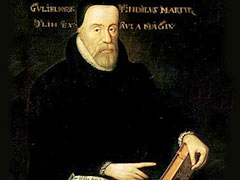
William Tyndale
Alter writes as if there was a direct, unmediated line from the Hebrew and Greek manuscripts to the KJV translators. But they did not work in such a vacuum. Rather, they relied on old, often flawed and error-prone manuscripts as well as a gaggle of previous translations, including the great Tyndale and Geneva versions and the Bishops’ Bible that the new version aimed to supplant. Indeed, much of what many today assume to be the catch phrases from the King James Version that have made their way into the common language made their way into the KJV first from Tyndale’s translations: “eat, drink and be merry,” “salt of the earth,” “give us this day our daily bread.” As Adam Nicolson notes in “God’s Secretaries,” his popular history of the making of the King James Bible, “Tyndale enthusiasts have calculated that 94 percent of the New Testament in the King James Bible is exactly as Tyndale left it.”
This is not to argue that the King James Bible had no influence on American prose style, but to suggest that Alter fails to engage the complexities and nuances of the Bible and its role in American culture. Symbolically, it might be noted, even that towering touchstone of American religious literature, John Winthrop’s famous 1630 “City on a Hill” sermon delivered aboard the Arbella before disembarking for the New World, drew its scriptural citations from both the Geneva and King James Bibles. But Alter appears to have adopted the conventional wisdom of conflating “the Bible” with the King James Version, and he seems to assert rather than demonstrate his thesis.
Alter is right about the widespread presence of the Bible in American culture, especially through the evangelical revivals of the eighteenth and nineteenth centuries, and its role in public schools through the nineteenth century and first half of the twentieth century. But whether the KJV did the work he suggests in shaping the nation’s prose, and thus its ideological construction of reality, remains contestable. He might have strengthened his case if he could have showed how the “style” of the King James Bible influenced the culture of the second half of the seventeenth century and the eighteenth century, the seedbed culture for Melville, for example. But Alter chooses generally to ignore the New England preaching tradition, the prose of Jonathan Edwards and the Founders, and the writing of Thomas Paine or Benjamin Franklin, where one would expect to find at least traces of the shaping influence of the KJV. Other than references to biblical place names and covenant theology tropes associated with “the New Israel,” he virtually ignores American writing until the mid-nineteenth century.
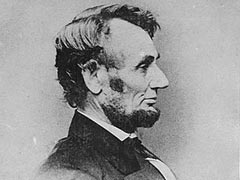
Abraham Lincoln
Alter does stop along the way to consider Lincoln’s Gettysburg Address and the certain stylistic influence the King James Bible had on that classic American speech. Here his analysis is concise and incisive, but he might have pointed out that the address was not really meant as a work of prose to be read, but rather a speech to be heard, and one reason it seems to reach so effortlessly to the KJV for its style is that the KJV was also meant to be read aloud, replacing the Bishops’ Bible in the liturgical life of the Jacobean church. In many respects it could be argued that the power of the King James Bible resides in its oral rather than written nature, and Alter might have done better to look at its influence on Puritan preaching, revival camp meetings, and the sermons of Billy Sunday and Billy Graham, not to mention Martin Luther King Jr.
Interestingly, Alter notes that while African-American culture is steeped in the Bible, the only African-American work he considered for inclusion was Ralph Ellison’s “Invisible Man.” Unfortunately, he writes, “a renewed inspection of its prose revealed only oblique and episodic links with biblical style.” One wonders why he didn’t look at the work of James Baldwin or Toni Morrison or Richard Wright.
Alter’s case would also be strengthened if he could show the pervasiveness of the KJV’s influence—how the language of the Bible made a difference in the texture of American prose, its sound, syntax, and idiomatic usage—in more than one work by his chosen writers. Did the KJV influence not just “Moby-Dick,’’ published in 1851, but also “White Jacket” (1850) and “Pierre” (1852)? Was it part of the cultural air Melville breathed, or was it one voice among many, like the seaman’s jargon he also adopted in his prose? Was it all-permeating for other nineteenth fiction writers—for Nathaniel Hawthorne, for Harriet Beecher Stowe?
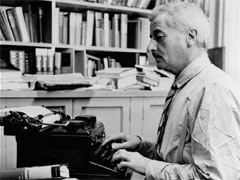
William Faulkner
Alter’s reading of “Moby-Dick” is his strongest at finding elements of the KJV style in a work of fiction. In contrast, the chapters on Faulkner and Bellow, in which he has many interesting things to say about each writer and the work he chooses to look at, are not very persuasive for his overall argument. To his credit, Alter picked in Faulkner a writer whose language is a near absolute antithesis to biblical style (unless one thinks of the intricate sentences of Paul) to argue there is “a set of biblical terms” in “Absalom, Absalom!” that “insistently recur” as a counterweight to the nonbiblical language and that are crucial to its meaning. “The King James Version enters into Faulkner’s otherwise anti-biblical prose not as a stylistic strategy but as a thematic lexicon,” writers Alter. He mentions birthright, curse, land or earth, name and lineage, sons or seed, but of course these words even as concepts are not unique to the King James Bible and certainly could be carried by other streams in the culture, including popular preaching, the Book of Common Prayer, or even the writing of pro-slavery southerners at the time of the Civil War. Even as “Absalom, Absalom!’’ reworks a biblical story, Alter’s claim seems a stretch.
Ultimately, what Alter shows in these close and interesting readings is that a handful of American fiction writers used a handful of techniques from a handful of Old Testament sources that also appear in parts of the King James Version to enhance their fiction. That this happened over a century in which the Bible was losing its religious significance for large parts of the elite culture is interesting, even provocative, and worthy of more attention. In fact, Alter begins to address the question in some of his comments on Melville. But his basic case, that the King James Bible determined “the foundational language and symbolic imagery” of the wider American culture, has not been made.
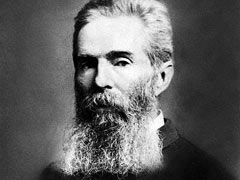
Herman Melville
In many ways, the collected essays in “Invisible Conversations” take up the paradox of the apparent waning of religious and biblical culture in American intellectual life even as the people as a whole continued to assert their religious identity and find meaning in the regular reading of the Bible. There is an academic intramural quality to some of the writing here. Edited by Wheaton College English professor Roger Lundin, the essays were developed out of presentations made in the American Literature and Religion Seminar, a project at the University of Notre Dame. (Another collection of essays by seminar participants, “There Before Us: Religion, Literature, and Culture from Emerson to Wendell Berry,” was published in 2007.) But overall they are a bracing companion to Alter’s book, charting and contesting the wider context of his reading. Alter’s chapter on Melville, for example, would have been a fitting contribution to “Invisible Conversations,” while many of these essays could have deepened his sense of the religious aspects of American culture.
Lundin’s book takes its title and underlying assumption from a belief that there has been in the United States a lack of interest in the religious aspects of American literature among scholars in the academy and a “stubborn refusal to engage religious questions on anything like their own terms.” Whether one agrees with that or not, the essays collected here with the aim of dispelling that ignorance and invisibility are fascinating, instructive and thought-provoking. They trace a wide arc, mostly concentrating on fiction and poetry, but also—as in Alan Wolfe’s essay on the role of religion in postwar nonfiction and Andrew Delbanco’s rejoinder—engaging mid-20th century social-science writing as well as—in Mark Noll’s essay on African Americans, the Bible, and slavery—memoirs, sermons, and other nonfiction genres in African-American literature.
The book structures itself as a dialogue between a chapter and a response—the conversation made visible, as it were. All of the selections have something to offer for further reflection and often pull readers deeper into their subject. As the responses make clear, many also invite argument. For example, is it really, as Stanley Hauerwas and Ralph Wood insist in their essay on theology and American literary tradition, the fault of “the churches” (whatever that might mean) that “a nation with the soul of a church” has “produced so few writers who are Christian in any substantive sense of the word,” and does one want to even argue that America has produced few “substantive” Christian writers?

Phillis Wheatley
The largest section of the book—three essays and a response—considers the oft-neglected area of literature, religion, and the African-American tradition, one of the main currents forming American culture and the area in which Alter said he could find no significant work exemplifying his notion of the stylistic influence of the King James Bible. There are many important insights in these chapters, and Katherine Clay Bassard’s study of the “sign of the cross” in African-American literature is a fascinating reading of the tradition, from eighteenth-century poet Phillis Wheatley through Toni Morrison’s 1997 novel “Paradise.” But a comment by Princeton religion professor Albert J. Raboteau is especially worth pondering: “The astounding flexibility of our culture to include the stories of the invisible or the forgotten disguises the fact that their stories have been included but not fully incorporated.” It is a fitting and pointed reminder that despite the insistence by some that we live in a post-racial society, even in literary studies there is still more tokenism than canonization. Ellison’s invisible man remains as invisible as the religion the writers here seek to make visible.
The two opening essays, literary critic Denis Donoghue’s “Finding a Prose for God” and Harvard professor of American literature Lawrence Buell’s spirited rejoinder, “American Literature and/as Spiritual Inquiry,” lay out the key positions for two opposing views of how to read the American literary canon through a religious lens. But they also point to the larger debate in American culture, including its political culture, between religion and spirituality.
Donoghue takes his cue from a line by the poet Wallace Stevens, “We say God and the imagination are one” (from the poem “Final Soliloquy of the Interior Paramour”). He proposes that in the American canon from Emerson on, “modern American literature is a substitute for religion, but a substitute in which the original has been absorbed.”
Donoghue does not argue that literature is a “valid or effective substitute” for religion, but that for writers in the dominant tradition belief is reduced, replaced, and almost erased. He writes of Hawthorne, for example, that he “replaced God with nature and community.” Emily Dickinson’s poetry, he argues, “had to be eccentric and probably willful, because it did not issue from a living tradition of faith and observance.” It is the “living tradition” that is reduced over time in the American canon.
But to show that traditional, sacramental religion has not been wholly eclipsed, Donoghue examines Andre Dubus’s “A Father’s Story” and its narrator’s conversation with God. While earlier writers could not find a prose with which to converse with God, Dubus’s narrator can. What enables this, Donoghue writes, “is his membership in the Church, the sacraments, the rituals, the Mass, Confession and Communion.”
In his reply to Donoghue, Buell reads the literary history of the United States differently. He sees the canonical nineteenth-century writers—Emerson, Hawthorne, Melville, Dickinson—as less religiously attenuated. “American literature,” Buell argues, “is and has for centuries been imbued with spiritual striving, even though that striving mostly expresses itself in willfully idiosyncratic forms whose larger public office is to hold up a mirror to the dominant culture’s stolid complacencies.”
The effort by Donoghue—and by Hauerwas and Wood in their essay—to tie the category of the religious to particular institutionalized faiths needs to be challenged. “Why should not the religious be identified mainly, if not exclusively, with the arenas of moral or spiritual inquiry and practice rather than with theologic belief or church affiliation?” Buell asks.
The distinction between religion understood as institutionalized, even sacramentalized faith and religion as individualized spiritual seeking or striving lies at the heart of the American literary tradition as reflected throughout the essays in “Invisible Conversations.” It is also part of the wider debate over what constitutes authentic American culture and values. It is not too much to say that the American canonical tradition, including those streams of it such as African-American, feminist, or gay writing, is a two-way street. How you read the literature influences and is influenced by how you read the culture: religiously weak or spiritually robust? It is an argument central not only to academic literary studies but also to political life and the life of faith.
David E. Anderson is senior editor of Religion News Service. He has written recently for Religion & Ethics NewsWeekly on nuclear disarmament, as well as on Marilynne Robinson, John Updike, and Flannery O’Connor.





